Here is a list of publications and presentations by Hein Zegers (click to view list) compiled by the KU Leuven University library system Lirias.
Mental Health for International PhDs

Invited as well-being psychologist / speaker at the Aristotle University of Thessaloniki, the largest university in Greece, to speak about ‘Mental Health for International PhDs’. Kudos to the whole Greydient Team for treating this relevant topic in such a constructive manner!
Op zoek naar existentiële zin
van Deurzen, E. & Zegers, H. (translation) (2019). In search for existential meaning (Op zoek naar existentiële zin). In: Tijdschrift Positieve Psychologie, Mei nr. 2, 2019
Bach Prelude BWV 999 in KADOC chapel
J.S. Bach’s Prelude BWV 999 on baroque alto recorder (A=415). With the sun almost magically breaking through the clouds when the musical tension dissolves at the end. An excellent (and extremely challenging!) etude in using the recorder’s entire span of almost 3 octaves. Arranged and performed by Hein Zegers.
Originally an etude written for ‘Lautenwerck’, an enigmatic instrument that is often characterized by having 3 octaves and extra soft bass notes (gut strings).
Performed in KULeuven University’s KADOC Chapel (Documentation and Research Center on Religion Culture and Society). This venue has brilliant acoustics for pseudo-polyphonic pieces such as this one. Pseudo-polyphony is a techique in which the recorder excels thanks to its extremely transparent and direct articulation.
BASICS and Essencing as a Positive Psychology Clinical Intervention
Zegers, H. & Verheyen, E. (2018). BASICS and Essencing as a Positive Psychology Clinical Intervention. Positive Clinical Psychology: An International Perspective. Issue 1, Fall 2018.
Abstract: Clients sometimes report having too many activities and/or too much ‘stuff.’ This problem is addressed in an intervention called ‘Essencing.’ Essencing is a concept that emerged from an international empirical research into experienced ‘voluntary simplifiers.’ As an intervention, Essencing has already been pilot tested in culturally diverse psychotherapy and counseling settings. In this article, we first succinctly describe its underlying BASICS Therapy model and its links with positive psychology. Then we give a short step-by-step description of the intervention. We conclude with a case study illustrating the practical use of the Essencing intervention. This intervention was a finalist in IPPA’s Clinical Division’s first Avant-garde Positive Psychology Clinical Interventions Competition at the fifth World Congress on Positive Psychology.
All we need while long-distance hiking: find out what’s essential
Long-distance hiking is an excellent way to get rid of excess clutter. It teaches you what you really need. This is the list of items that we ended up carrying on our long-distance hike. Not suggesting that this is all you will need, it’s just to give you an idea of all we needed to survive and thrive at that moment.
With all our necessities on our back, we’ve walked about 400 km (250 miles): England’s South West Coast Path, from Bristol/Minehead (Somerset) to Newquay (Cornwall). This beautiful path can be strenuous, with lots of steep ascents and descents, so you get very selective in what you carry.

Basic hiking gear:
- 65 liter lightweight Backpack
- Walking sticks (when carrying a trekking backpack)
- My trusty double flutes (they go everywhere I go)
Sleep & Shelter:
- Lightweight 2-person tent (about 2kg/4Lbs with groundsheet)
- Lightweight inflatable sleeping pad
- Lightweight sleeping bag
- Earplugs & sleeping mask
- Sleeping bag liner (especially for colder nights)
Food & Drink:
- 2 water bottles within easy reach
- Large water bladder inside backpack
- Titanium cooking pot
- Spork & Swiss knife
- Lightweight stove with fuel & lighter
- Dry meals
- Soluble coffee & chocolate
- Power bars / flapjacks
- Trail mix
Health & Hygiene:
- Towel
- Wet wipes
- Toilet paper
- Hand sanitizer
- Glasses / contacts
- Small toothbrush & toothpaste
- Water purifying tablets
- Deodorant
- Soap (doubling as shampoo and laundry soap)
- Sunscreen (on top of hat & long-sleeved clothing)
- Paracetamol, anti-diarrheal, bandages, preservatives, insect repellent
- Nail clipper (especially for the feet)
- Shaver
- Sanitary waste bag
Clothing:
- Quick-dry Pants & Shirt
- Trail runners
- Best possible hiking socks (very important to prevent injuries)
- Hat
- Lightweight rain jacket
- Pack cover
- Fleece pullover
- Down Jacket
- Clean sets of socks and underwear
- Pants & T-shirt for the night while laundered day clothes are drying
- Buff (doubling as a pillow case)
- Light water shoes to wear at camp
Electronics:
- Cellphone (for communication, research, pictures, reading, …)
- Power bank
- Headlight (USB chargeable)
- Charger with 4 USB slots & cables
- All in a waterproof zip-lock bag
Various equipment:
- Lightweight foldable mini-backpack
- Guidebook
- Area map
- Sky map for stargazing
- Book (In this case: Henry David Thoreau’s essay ‘Walking’)
- Light lock
- Passport, Credit Card, Cash, Paperwork
- Duct tape
- Rope
- Pencil
- Repair set for tent & sleeping pad
- Large Ikea zip bag (FRAKTA) protecting backpack in public transport
- Waste bags (Leave No Trace!)
This is all we really needed. Base weight: about 10kg / 20 Lbs.
Playing in Merlin’s Cave at Tinagel Castle (Cornwall)
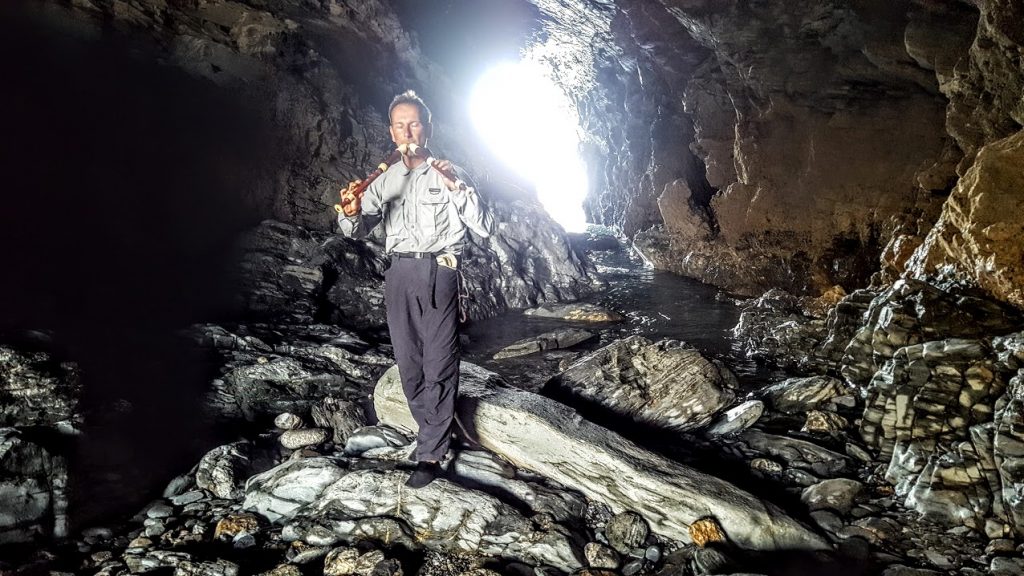
Performance in ‘Merlin’s Cave’ at Tintagel Castle in Cornwall, where mythical King Arthur is said to be born. Brilliant acoustics – when the tide is low, that is. When the tide is high, this cave is entirely filled with water. Cheers to Julian Goodacre for introducing me to the Cornish Double Pipes tradition and some of its tunes that can be played on double recorder!
European Conference on Positive Psychology
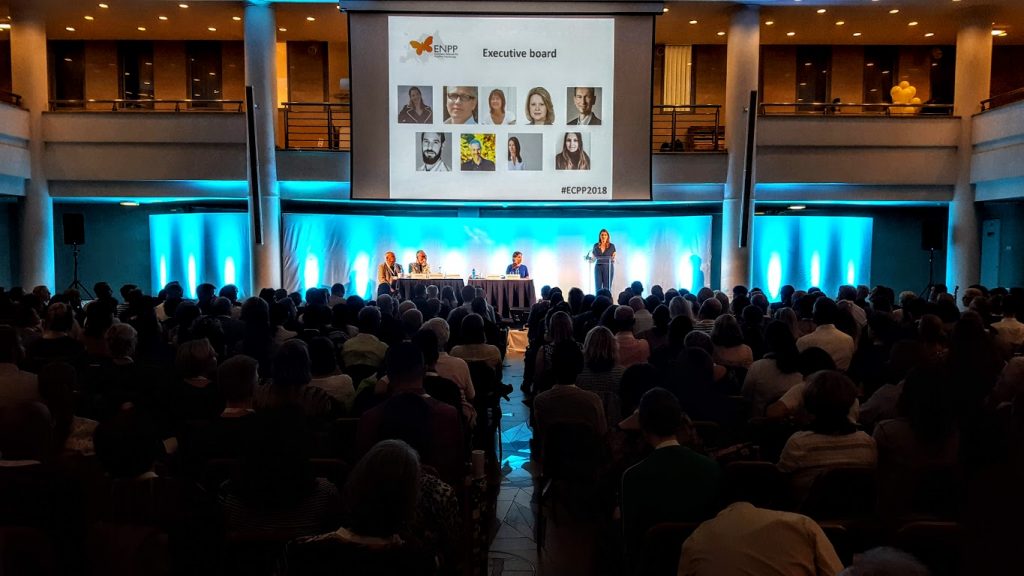
This year’s largest Positive Psychology event worldwide: the European Conference on Positive Psychology 2018, with almost 1000 participants. As board member of the European Network of Positive Psychology, I was partly involved in organizing this event, next to leading a few symposia.
Playing with String Ensemble Rosamunde
String Ensemble Rosamunde, conducted by Peter Pazmany, invited Hein Zegers to play together with them as a soloist on recorder. What a joy to play alongside such passionate musicians! Here are a few impressions (photography by Paul Rogier):
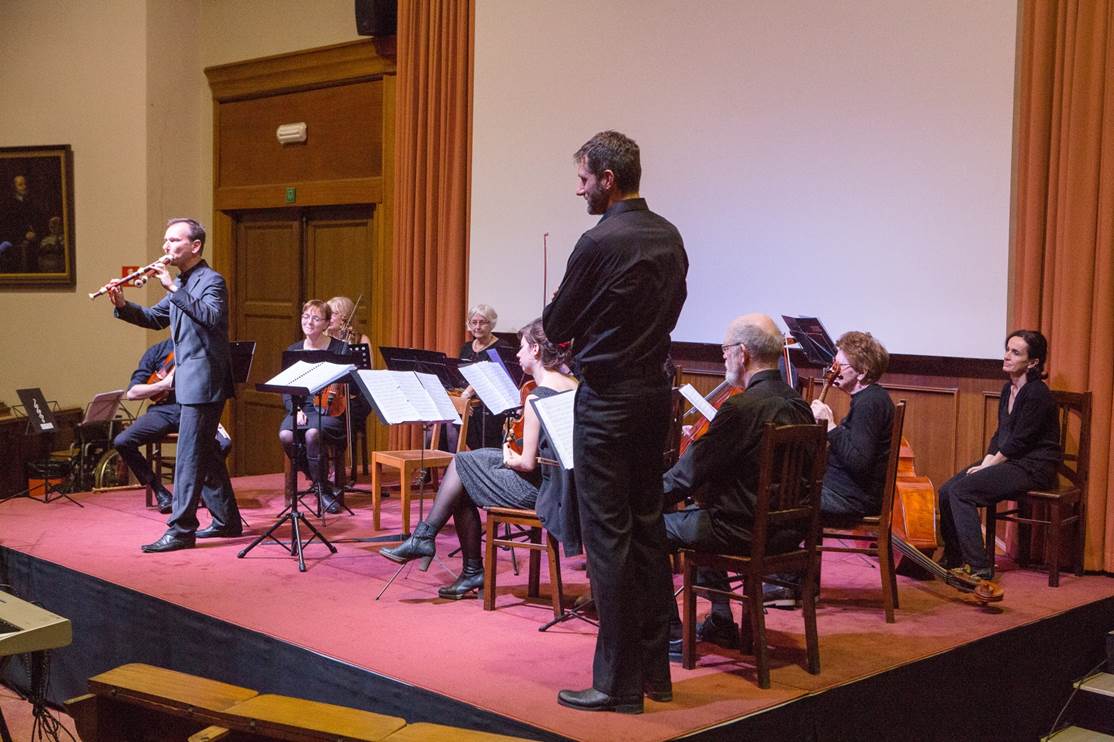
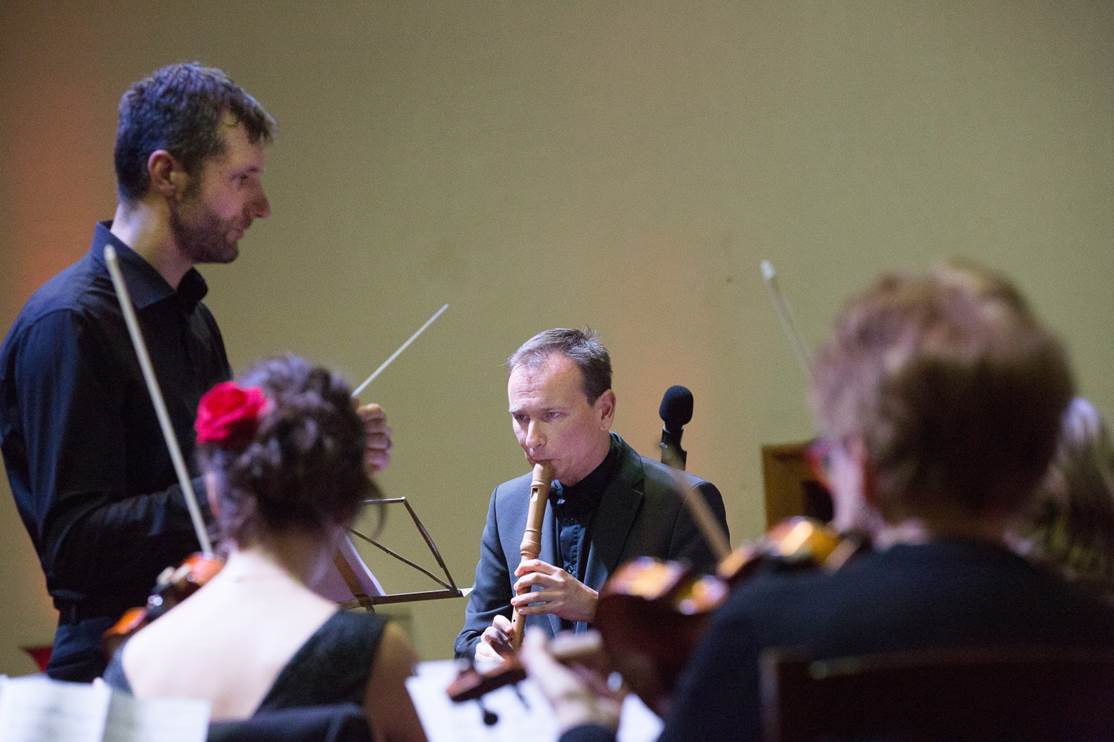
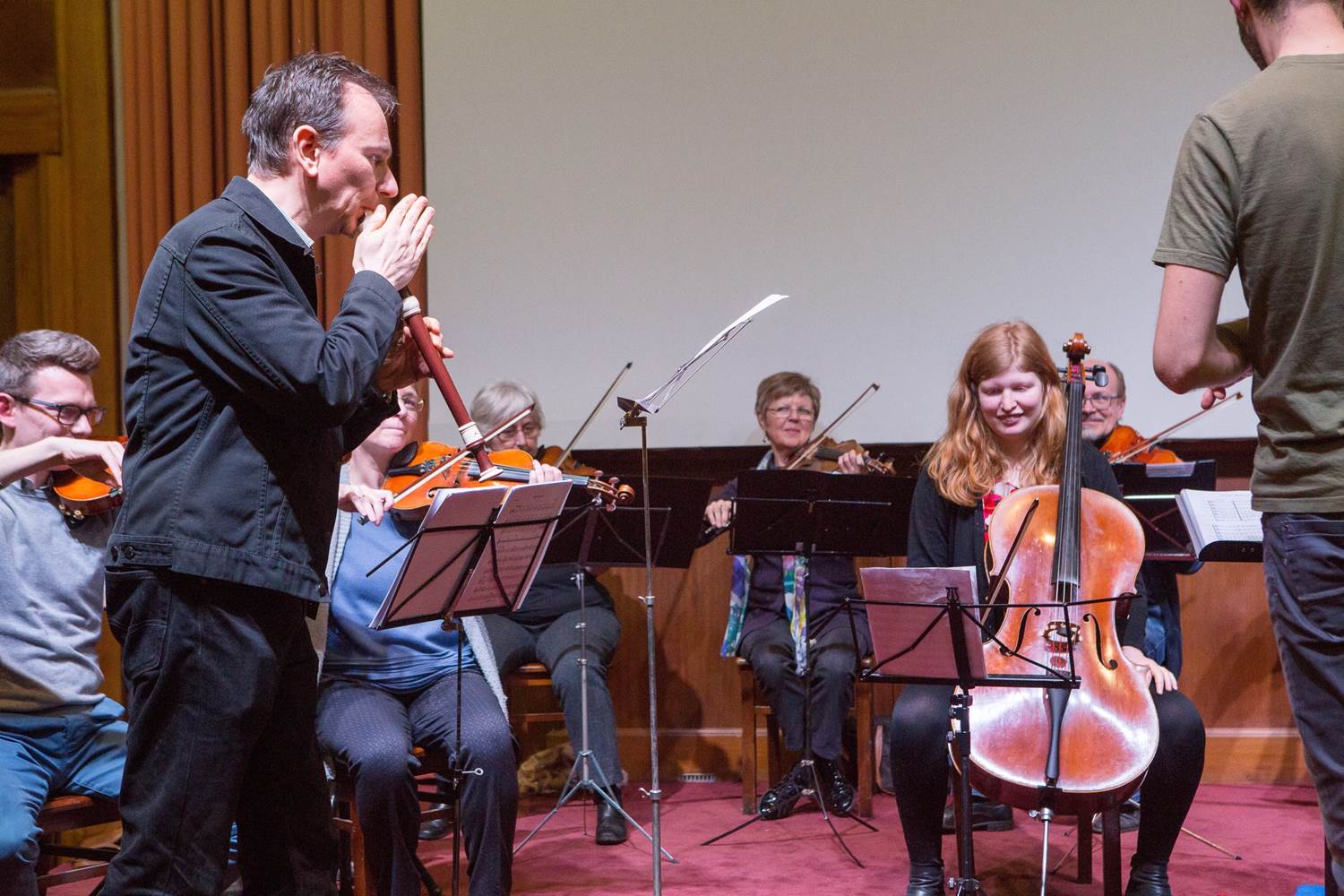
Playing on top of Table Mountain, Cape Town, South Africa.

A musician has got to do what a musician has got to do. Playing on top of iconic Table Mountain in Cape Town.
What makes you happy? A cross-cultural cross-disciplinary Nomadic Inquiry
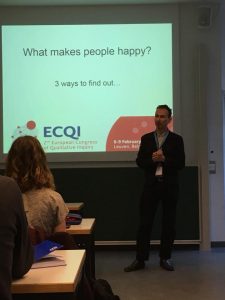
Zegers, H. (2018). What makes you happy? A cross-cultural cross-disciplinary Nomadic Inquiry. Presentation at the European Congress of Qualitative Inquiry, Leuven, February 6-9, 2018.
Playing in Kazachstan
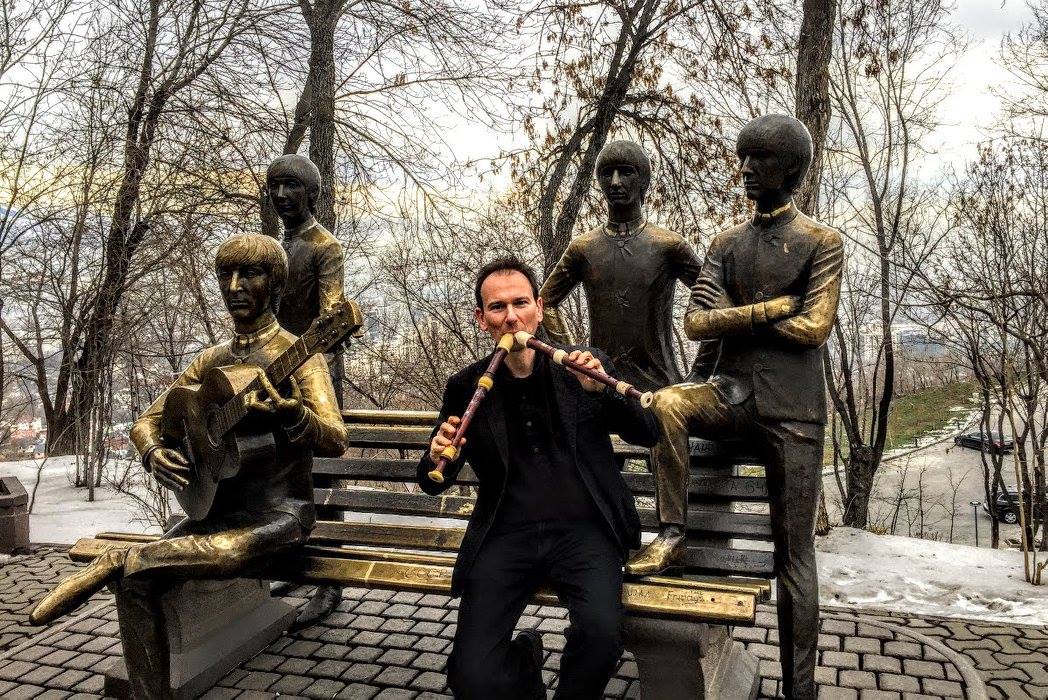
Playing with the Beatles in the very culturally diverse city of Almaty, Kazachstan.
How to become the happiest country on Earth twice

The Gallup Well-Being Index has declared this tropical country the happiest on Earth. Not once, but twice upon a time. So as an international well-being researcher, I felt compelled to travel there and explore possible explanations for these statistics. Why are people in this small country so happy? What is it that makes its people flourish? What can we learn from them? Join us on our field research trip to… Panama.
Money

Who says Panama, says canal. The Panama Canal is worth about one billion US$ each year. It is the largest contributor to the economy of this small central American country. So to what extent could this explain the happiness of its citizens? From country-level research, we know that inhabitants of exceptionally poor countries tend to be unhappy indeed. But once a certain income level is reached, extra money does not seem to make a country as a whole much happier any more. This phenomenon is known as the Easterlin Paradox (which I explain in this video). So the Panama Canal revenues may have increased well-being at first, but may not add too much of it any more.
Weather

Panama is a tropical country in every sense of the word. It is hot and humid. Yet generally speaking, weather and sunshine do not seem to correlate with country well-being. For some people, not enough light in winter may lead to a disorder called “depression with seasonal pattern”, so on an individual basis, weather can impact your well-being indeed. Yet on a country level, there hardly seems to be a correlation with well-being. Which is good for Panama, because it does have a rainy season (though still very hot).
Diversity

The flora and fauna in Panama is extremely diverse. This is probably due to this narrow strip of land where all kinds of creatures from all over the continent converge. The same applies to the Panamanian population, which is equally diverse and colorful. Research indicates that diversity not always associates positively with well-being, but Panamanians seem to have found a way to live harmoniously together in an easy-going tolerant way of life.
Care

People in Panama seem to have a high level of trust in their future and (to a somewhat lesser degree) in each other. From country-level research, we know that trust is strongly associated with well-being. Also the opposite is true: if you cannot trust your fellow countrymen (as when they seem corrupt), chances are your country suffers from low well-being indicators. My personal impression is that on average, Panamanians seem to care about each other. And as Prof. Chris Peterson summarized his decades of well-being research in three simple words: ‘Other people matter’.
So how did Panama become so happy? It is always difficult to pinpoint causal relationships, but it appears to me that it may at least be partly due to its culture that treasures diversity, tolerance, optimism, warmth and care for each other.
Full house for presentation on Clutteritis & Minimalism
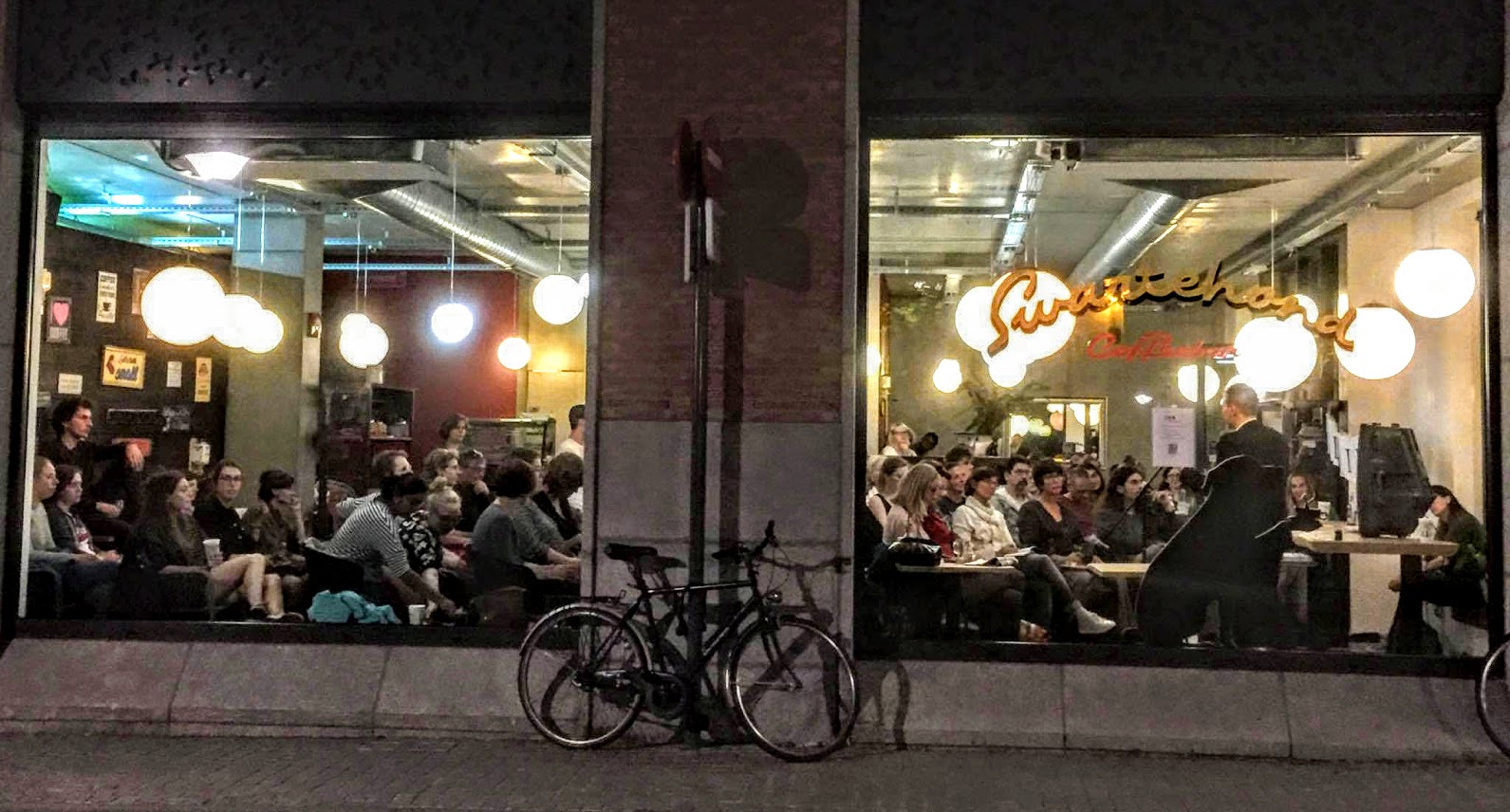 Full house yesterday for Hein Zegers’ presentation on Clutteritis & BASICS, organized by the Leuven Think Tank CEO. The contents of the book ‘Zooikoorts’ (‘Clutteritis’) clearly hit a nerve: “We’ve never had so many people here.”
Full house yesterday for Hein Zegers’ presentation on Clutteritis & BASICS, organized by the Leuven Think Tank CEO. The contents of the book ‘Zooikoorts’ (‘Clutteritis’) clearly hit a nerve: “We’ve never had so many people here.”
Zooikoorts (Clutteritis) in Libelle Magazine
Hein Zegers: ‘Op jonge leeftijd verloor ik mijn beide ouders en mijn enige broer. Daardoor gaat een mens misschien wat sneller nadenken over wat nu écht belangrijk is. Het leven is zo fragiel en kostbaar, zonde om het te verspillen aan krampachtig verzamelen van spullen en zinloze drukte.’
Uit: Libelle Nederland Special (September 2017), dat zes volledige pagina’s wijdt aan ‘Zooikoorts’ (naar het gelijknamige boek verschenen bij Lannoo).
(English version below)
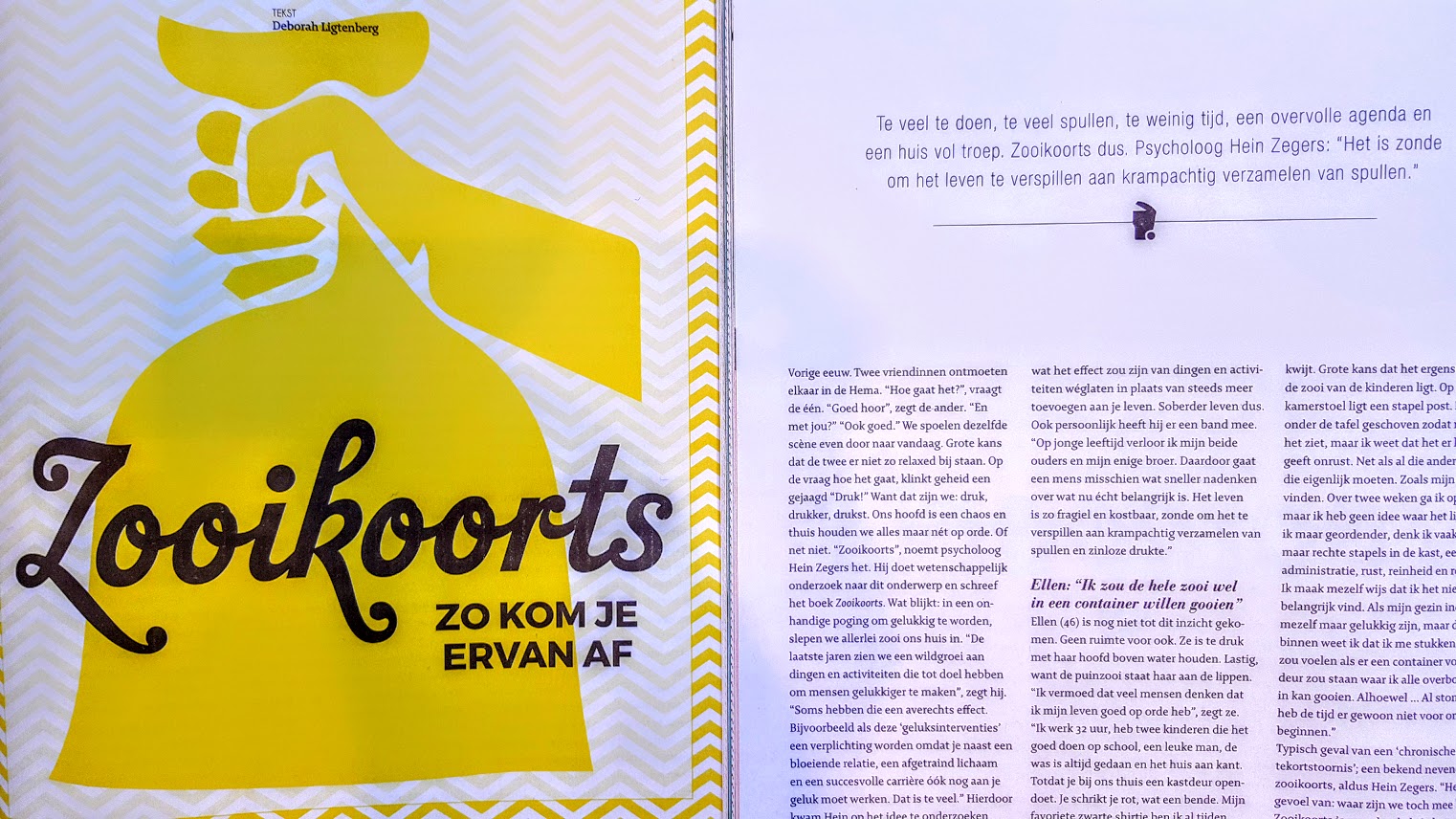
Hein Zegers: ‘At a fairly young age, I lost both my parents and my only brother. Maybe that makes a person think twice about what is really important. Life is so fragile and precious, what a pity to waste it gathering stuff and being mindlessly busy.’
Excerpt from Libelle, the oldest Dutch Women’s magazine. Special September 2017 issue that spends six full pages on the subject of the book ‘Clutteritis’.
Double Interview with Emily Esfahani Smith & Hein Zegers

Fragment from a double interview with Emily Esfahani Smith & Hein Zegers in Marie Claire (Belgium), September 2017, p. 96-98 (“There is more to life than being happy”):
Hein Zegers, Well-Being researcher and author of Clutteritis (Zooikoorts, Lannoo Publishing) also has mixed feelings about the happiness hype. “Happiness studies are often about averages, but a human is no average. Take soccer, for example. To some, soccer is the ultimate happiness booster, whereas for others, it is a nightmare. Or take mindfulness: it may be beneficial, but not for everybody. Or take people that are mildly depressed: they tend to become even more depressed when they are exposed to the well-meaning advice of a happiness guru.
Next, there is the compulsory character of the happiness industry. It is as if we are almost obliged to be happy. Just living a satisfied life is not enough these days, it has to be wild and exciting. Before we know it, we are busy keeping up appearances all day. Loudly proclaiming, like a Hyacinth Bucket, how incredibly happy we are.
Beating stress and burnout with BASICS

How can companies protect workers against stress and burnout? Well-Being researcher Hein Zegers shares his insights on the topic.
“The BASICS therapeutic approach is a routine based on empirical research conducted among people who consciously choose a more brain-friendly environment”, he explains in an interview with Mensura, Belgium’s largest External Occupational Health Service.
BASICS is the acronym for Back (taking a step back), Attention, Select (what is really essential), Invest (in what is essential) and Cut (what is not essential). By cutting down on the number of activities or tasks on your to-do list, you will experience more Sense (meaningfulness). Within a work context, the BASICS method often translates into the 80/20 rule: 20% of your carefully selected activities produce 80% of your positive results.
Full interview in English: Beating stress and burnout with BASICS
Volledig interview in het Nederlands: Blijf stress en burn-out de baas met de BASICS-methode
L’interview intégrale en français: Maîtriser le stress et le burn-out avec la méthode BASICS
Google: The happiest workplace on Earth?

According to the Great Places to Work index, Google is once again the top 1 employer this year. So as an international Well-Being Researcher, I headed towards Mountain View, California, and visited them to find out: is Google the happiest workplace on Earth?
How is it to work for the company that steers the world’s leading search engine as well as Gmail, YouTube, Android, Chrome, Maps, Translate, and literally hundreds of other applications? With many more in the pipeline, including self-driving cars (I’ve been inside one), contact lenses that measure your glucose levels, internet balloons, home automation, individualized medicine, life extension technology, etc…?
Free Lunch
Are Google Employees happy indeed? For sure, Google has been known for its many employee perks. There are free laundry facilities, children’s day care, you can even get a free haircut.

We know from research that physical movement is good for your subjective well-being. And indeed, Google offers all kinds of free sports facilities, including free gym, Yoga and fitness classes and a central beach volley court, just to name a few.
Happy Bike
Google’s free multi-colored bikes are everywhere: as an employee, you just grab one to move from one building to the other. From country-level research, we know that using bikes is strongly correlated with happiness. But using bikes at Google is not only healthy and happiness-inducing, it’s also practical: Google Campus is so huge that on foot, you can keep walking for half an hour straight and still be on Google grounds.

The food trucks and cafeterias offer free and healthy food. Their interior is simple but effective, and remind me of my favorite Alma Mater student restaurant. As many employee facilities here, they offer plenty opportunity to network and be among other people – one more factor that we know from research as essential to our well-being.

Evil?
Google has a clear mission statement: to organize the world’s information and make it universally accessible and useful. Until recently, the unofficial mission statement had been ‘Don’t be evil’. Recently this has been replaced by ‘Do the right thing’. Which, psychologically speaking, makes sense: most parts of our brain cannot process negative utterances, so I suppose there was the danger that with a statement like ‘Don’t be evil’ only the ‘evil’ part keeps sticking…

Google claims to actively embrace diversity, and that is visible: the workforce is extremely international, you hear all kinds of languages spoken on campus, facilities abound when you’re a parent or pregnant, there are gender-neutral toilets, etcetera.
Ageism
One of my quirks is that next to investigating everything there is, I also love to look for what is not present. So it struck me that one category of people is clearly underrepresented: the elderly.
Thomas, a former Googler from Belgium, explains: ‘First you do your thing at Google for a few years. Then your work experience is becoming so valuable, that you can seize better opportunities at other companies. That’s also what I’ve done. But generally speaking, Google is indeed a great place to work.’
The Psychology of Minimalism
The Psychology of Minimalism: Will dumping your junk make you happier? Article by ‘Zillionist’ based upon research by Hein Zegers.
Playing at Thoreau’s Hut at Walden Pond
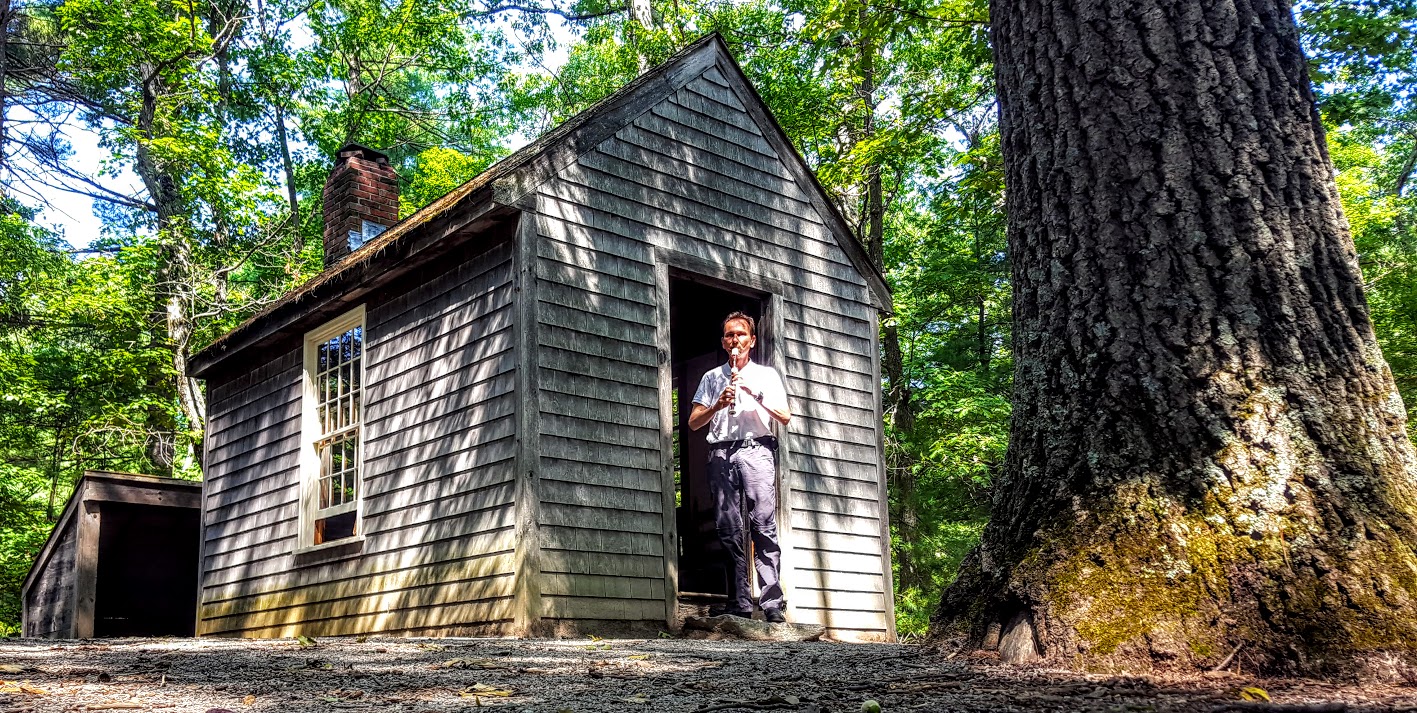
This is where H.D. Thoreau lived for more than two years in the middle of the woods near Walden Pond. This is where he liked to play his flute. This is also where he got his inspiration for the literary masterpiece ‘Walden’, one of the most influential texts within the Voluntary Simplicity movement.
BASICS & Essencing win ‘Avant-Garde Positive Clinical Intervention Challenge’

Zegers, H. & Verheyen, E. (2017). BASICS & Essencing as a Positive Psychology Clinical Intervention. Award-winning presentation at the World Conference on Positive Psychology 2017 in Montréal.
Voluntary Simplicity, Well-being and Meaning in Life. A Multilingual Empirical Study of 500+ People who Consciously Choose for Simple and Slow Living.

Zegers, H. (2017). Voluntary Simplicity, Well-being and Meaning in Life. A Multilingual Empirical Study of 500+ People who Consciously Choose for Simple and Slow Living. Podium Presentation at the 5th World Congress on Positive Psychology, Montréal, July 13-16, 2017.
Bach ‘Air’ on double flute
J.S. Bach: ‘Air on the G string’ on double flute / double recorder by Hein Zegers. Using two alto recorders modeled after Joannes Hyacinth Rottenburgh (1672-1765) as echo flutes. Played in Autobahnkirche Medenbach, where long-distance travelers come and go, day and night, and could do so at any time during this performance.
We wish you a merry Christmas and much more (on double flute)
Bluesy version of ‘We wish you a merry Christmas’ on double recorder / double flute. From classic to swing to crazy. On 2 alto recorders refined with natural beeswax, according to an ancient ‘tibiae pares’ / echo flute tradition. By Hein Zegers.
Positive psychology: essential knowledge
Zegers, H. (2016). Positive psychology: essential knowledge. Instructional videoclip in Leijssen, M. (Ed.), Existential Well-being Counseling. A Person-centered Experiential Approach. MOOC edX, published online october 1st, 2016. Link: https://www.youtube.com/watch?v=NxkyzeARH3o
Measuring Well-being
Zegers, H. (2016). Measuring Well-being. Instructional videoclip in Leijssen, M. (Ed.), Existential Well-being Counseling. A Person-centered Experiential Approach. MOOC edX, published online october 1st, 2016. Link: https://www.youtube.com/watch?v=c9vePGoipu0
Richer but not happier?
Zegers, H. (2016). Richer but not happier? Instructional videoclip in Leijssen, M. (Ed.), Existential Well-being Counseling. A Person-centered Experiential Approach. MOOC edX, published online october 1st, 2016. Link: https://www.youtube.com/watch?v=2CxzN7y8pYA
Simplicity as a Well-Being Attitude
Zegers, H. (2016). Simplicity as a Well-Being Attitude. In Leijssen, M. (Ed.), Existential Well-being Counseling. A person-centered Experiential Approach. MOOC edX, published online october 1st, 2016.
Happier with a Gratitude Diary
Zegers, H. (2016). Happier with a Gratitude Diary. Instructional videoclip in Leijssen, M. (Ed.), Existential Well-being Counseling. A Person-centered Experiential Approach. MOOC edX, published online october 1st, 2016. Link: https://www.youtube.com/watch?v=iMtBEMeWLmU
Performing on the Charles Bridge in Prague

Last time I visited Prague, I was still a teenager. I hitchhiked around Europe back then, playing street music and searching for the meaning of life. Now, almost 30 years later, I’m doing almost the same, still not much wiser, but having a great time… Here, I’m Playing Smetana’s “Moldau” on the Charles Bridge. Meanwhile, the Moldau River quietly runs underneath.
Solo recorder improv on top of Mount Dobongsang, South-Korea

Playing for the birds. And for one passing friendly monk from a nearby monastery. Early morning, after hiking up to the top of Mount Dobongsan (South-Korea).
Playing ‘Alle Menschen werden Brüder’ in Amman (Jordan)
 Playing ‘Alle Menschen werden Brüder’ on two recorders. In Amman (Jordan), also formerly known as ‘Philadelphia’, the ‘city of brotherly love’. On top of its most famous landmark: the Amman Citadel (Jabal al-Qal’a).
Playing ‘Alle Menschen werden Brüder’ on two recorders. In Amman (Jordan), also formerly known as ‘Philadelphia’, the ‘city of brotherly love’. On top of its most famous landmark: the Amman Citadel (Jabal al-Qal’a).
KU Leuven University

Hein Zegers has been co-authoring and co-moderating the introductory chapter of the KU Leuven University EdX MOOC ‘Existential Well-Being Counseling’ by Prof. Mia Leijssen. He has also been giving guest lectures at several faculties of the university. He currently coordinates and teaches the course ‘Counseling in Existentieel Welzijn‘ for its Clinical Psychology department.
Ah vous dirai-je maman / Twinkle Twinkle Little Star on double flute
Pastoral folk song “Ah! Vous dirai-je, Maman”. Mozart- & “Twinkle Twinkle Little Star”-variations for double flute (an instrumental practice popular amongst early shepherds).
When Negative Emotions are Positive
Zegers, H. (2015). When Negative Emotions are Positive. In: Positive Psychology News, August 24, 2015. Link: http://positivepsychologynews.com/news/hein-zegers/2015082434668
Performance at the Venice Arts Biennale

Playing Vivaldi on Piazza San Marco during the Venice Arts Biennale
Simple Living, Valued Living. ACBS World Conference – Berlin.
Zegers, H. (2015). Simple Living, Valued Living. An international study of Voluntary Simplicity and Psychological Flexibility. Presentation at the World Conference of the Association for Contextual Behavioral Science, 2015, Berlin.
Performance in the world’s deepest subway station – Kiev, Ukraine
 Performance in the world’s deepest subway station with excellent acoustics for quasi-polyphony. Arsenalna Subway Station, Kiev, Ukraine.
Performance in the world’s deepest subway station with excellent acoustics for quasi-polyphony. Arsenalna Subway Station, Kiev, Ukraine.
Performing in Nanjing (China)

Playing simple tunes alongside Xuanwu Lake (玄武湖) in Nanjing (南京), China.
Händel “Barry Lyndon” Sarabande HWV 437
G.F. Händel Sarabande (from the Keyboard Suite D min) HWV 437, first published 1733. Well-known from the Stanley Kubrick Movie “Barry Lyndon”. Variations for double flute (recorder) by Hein Zegers. Using two alto recorders modeled after Joannes Hyacinth Rottenburgh (1672-1765) as echo flutes.
Jingle Bells Swing on double flute
Jingle Bells Holiday Song. Swing version for 2 recorders, simultaneous with some live voice and tongue percussion effects, by Hein Zegers (2014). Original by J. Pierpont (1857).
Chopin Tristesse on solo recorder (Étude Op. 10, No. 3)
The most beautiful melody ever written by Frédéric Chopin (according to himself): Étude Op. 10, No. 3 (“Tristesse”), 1832. Arrangement for alto recorder solo (2013) by Hein Zegers. Using the old technique of quasi-polyphony. The recorder is one of the best instruments to play quasi-polyphony, thanks to its very direct articulation.
UC Berkeley

Hein Zegers has been Teaching Assistant for the world’s very first MOOC on “The Science of Happiness” (University of California, Berkeley) for over 200.000 Students from all over the world.
Main Responsibility: Community Teaching Assistance for the first chapter “Introduction to the Science of Happiness”.
Te Deum – Charpentier (Eurovision Theme) on double flute
Eurovision Theme Music “Te Deum” by Marc-Antoine Charpentier (1643-1704). Arrangement for double recorder by Hein Zegers. Instruments: two alto recorders modeled after Joannes Hyacinth Rottenburgh (1672-1765), prepared and used here as echo flutes.
Ode an die Freude / Ode to Joy on double recorder
Ode to Joy (“all people become brothers”), in up to 3 voices on 2 recorders simultaneously.
Abstention as a Positive Psychology Intervention?
Zegers, H. (2014). Abstention as a Positive Psychology Intervention? Podium Presentation at the 7th European Conference on Positive Psychology, Amsterdam, July 1-4, 2014.
Rossini William Tell on double recorder
William Tell Overture, a.k.a. The Lone Ranger Theme Song. By Gioachino Rossini (1829). Adaptation for double recorder by Hein Zegers.
Eine kleine Nachtmusik on double recorder
Mozart’s “Eine kleine Nachtmusik” on 2 recorders, using ancient double flute techniques. Arrangement by Hein Zegers of the introductory theme of Mozart’s serenade nr. 13 K. 525.
Playing in front of Red Square / Kremlin (Moscow)
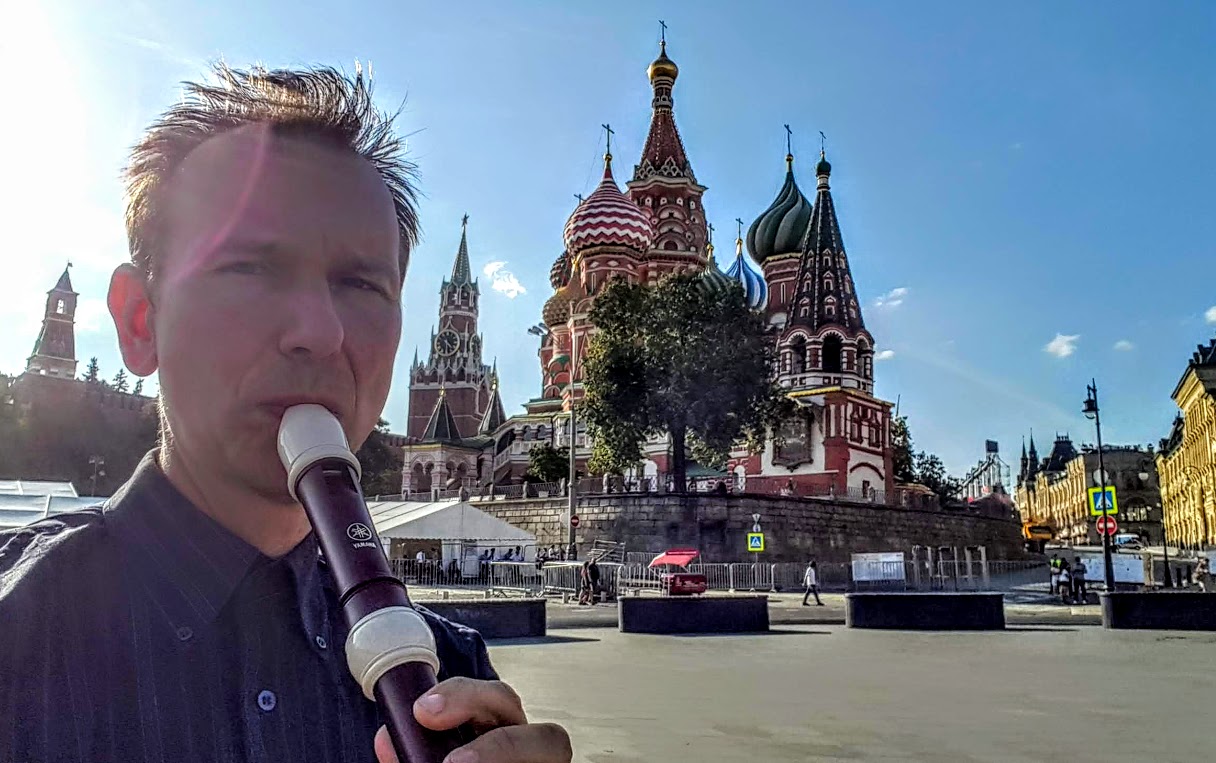
Playing in front of Red Square / Kremlin (Moscow). After playing on so many significant places all around the world, I just had to go and play here as well.
Evidence Based Happiness
Research website www.evidencebasedhappiness.org (published on the first UN-installed International Day of Happiness, March 20th, 2013)
Evidence Based Happiness vzw

Evidence Based Happiness vzw is a non-profit organization. Its mission is to spread the Science of Well-Being, in a way that is both understandable and scientifically accurate.
This educational/research organization obtained official non-profit status (“vzw”) on the first official United Nations World Happiness Day (March 20, 2013).
Through its numerous research and science dissemination activities, Evidence Based Happiness vzw has been touching the lives of more than ten million people worldwide, especially in the Dutch-French-English-German language area in Europe.
Evidence Based Happiness vzw embodies a large network of academics as well as practitioners. It is a spin-off of KU Leuven, recently rated by Reuters as the most innovative university in Europe. Its three co-founders are all licensed psychologists who graduated from this university: Liesbeth Vander Elst (Research & Sports Psychologist), Els Verheyen (Clinical Psychologist & Social Worker) and Hein Zegers (Clinical/Positive Psychologist & Science Communicator).
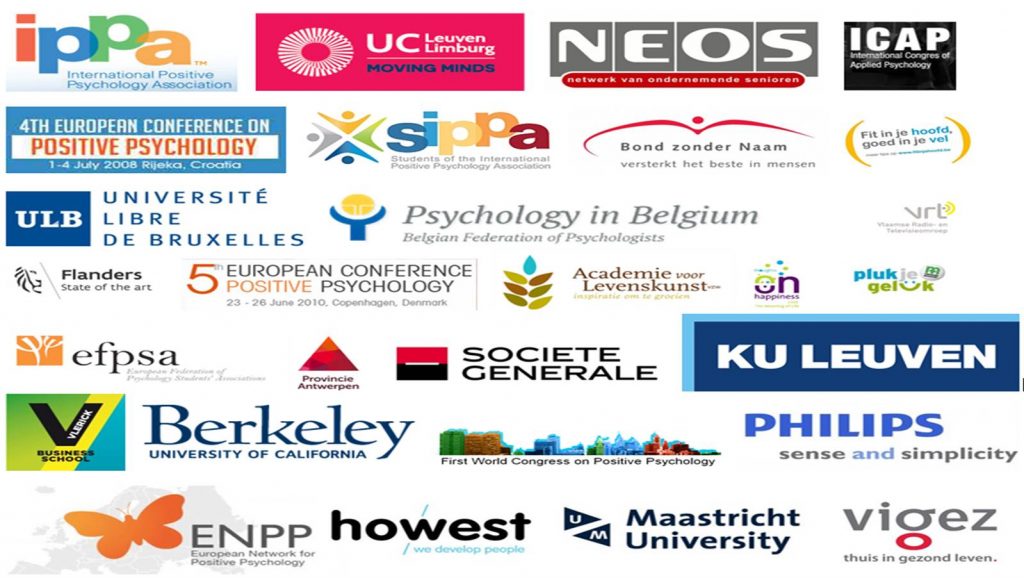
John Cage’s 4’33” on solo recorder
John Cage’s famous 4’33” piece on solo recorder. 3 Parts: I Tacet (on soprano recorder), II Tacet (on alto recorder), III Tacet (on soprano recorder). Performed in a public stairway with excellent acoustics for this instrument. Pedestrians may appear at any moment.
Love Me Tender on solo recorder
Solo recorder improvisation on “Love me Tender”. Playing up to 3 voices simultaneously (quasi-polyphony) in 3 variations by Hein Zegers. Song originally known as “Aura Lee” (1861), written by W.W. Fosdick & G.R. Poulton.
The Lion Sleeps Tonight on recorder
Recorder, recorder & some beatboxing, 2 recorders simultaneously. “The Lion Sleeps Tonight”-variations for solo recorder by Hein Zegers and some wild birds in the background.
A person is no average
Zegers, H. (2011). A person is no average. In L. Bormans (Ed.), The World Book of Happiness (pp. 330-331). Firefly Books.
Adagio Albinoni on solo recorder
Adagio in G minor by “Albinoni” (Giazotto) on solo recorder (simultaneously playing melody and bass line). Arrangement and performance by Hein Zegers.
Soboku Music. Simple Recorder Solo Music Channel.
Soboku Music (click to visit). Simple Recorder Solo Music Channel. Exploring music, the concept of Soboku (Japanese 素朴: pure simplicity), and Ockham’s Razor (as simple as possible, but no simpler than that).
2nd World Congress on Positive Psychology (Philadelphia)
2nd World Congress on Positive Psychology (Philadelphia, 2011. Presentation and co-organization of several events by Hein Zegers as a member of the SIPPA Steering Committee)
Keynote on EFPSA Conference in Borovice (Poland)
European Federation of Psychology Students’ Associations (EFPSA) Conference (Borovice, Polen, 2011, Keynote presentation on Positive Psychology by Hein Zegers)
Positive Psychology Book Reviews
Several Positive Psychology Book Reviews (2008-2011)
International Wellbeing Study Questionnaire – Dutch
Authorized Dutch translation of the “International Wellbeing Study” Questionnaire by Aaron Jarden.
Positive Psychology Interventions: A Cross-Cultural Exploratory Study.
Zegers, H. (2010). Positive Psychology Interventions: A Cross-Cultural Exploratory Study. Presentation on the 5th European Conference on Positive Psychology, Copenhagen, 2010.
Keynote International Congress of Applied Psychology
International Congress of Applied Psychology (Bruges, 2010, where Hein Zegers was Keynote speaker on Positive Psychology), organized by HOWEST.
Belgian Commission of Psychologists
Hein Zegers has been a licensed Psychologist since 2010.
Students of the International Positive Psychology Association

Co-Founder & first Executive Committee Member (Jan 2010-Jun 2012)
Hein Zegers has co-founded and served a full 2-year term as Executive Committee Member of SIPPA, the Student section of IPPA, the International Positive Psychology Association.
Main responsibilities: spreading the Science of Positive Psychology by setting up a world-wide network of local representatives & help recruiting over 1800 paying student members.
International Positive Psychology Association

IPPA Charter Member (since 2009)
First World Congress on Positive Psychology in Philadelphia
Zegers, H. (2009). What makes you happy? Looking for blind spots in happiness seekers … and researchers. Presentation on the First World Congress on Positive Psychology in Philadelphia (June 2009).
1st Dutch Positive Psychology Conference: Happiness Interventions @ Work
Hamburger, O., & Zegers, H. (2008). Happiness Interventions @ Work. First Positive Psychology conference in the Netherlands “Thoughts on Happiness” (November 2008).
4th European Conference on Positive Psychology in Croatia
4th European Conference on Positive Psychology in Croatia (July 2008) (participant).
Positive Psychology Summit 2007 Washington
Positive Psychology Summit 2007 Washington (as a participant from Europe, summit hosted by the Gallup Organization)
Positive Psychology Summit 2006 in Washington
Positive Psychology Summit 2006 Washington (as a participant from Europe, summit hosted by the Gallup Organization)
European Network for Positive Psychology

Hein Zegers has been ENPP Country Representative for Belgium (from 2005) & Board Member (from 2017)
Spreading the Science of Positive Psychology, especially in Belgium and the Dutch/French/German/English-speaking European area.
VVKP

Privacy Policy & Terms of Service
Pastoral Concerto for recorder and string orchestra

Pastoral Concerto for recorder and string orchestra (composed by Jan van Landeghem), solo part performed by Hein Zegers in Brussels, Belgium.
Playing in bands

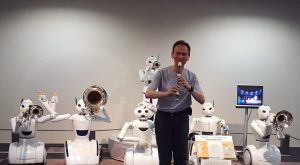




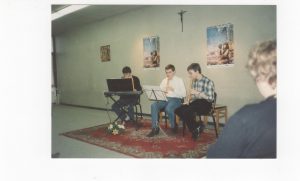
Student Busking around Europe




Teen recorder performance

